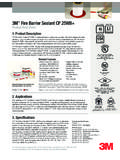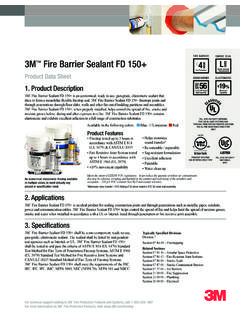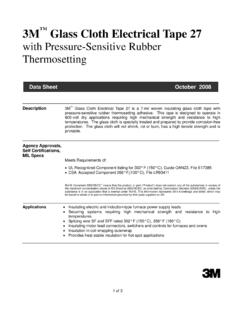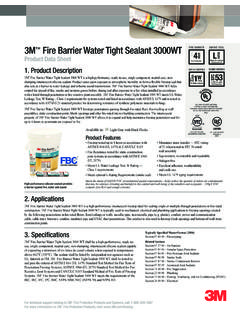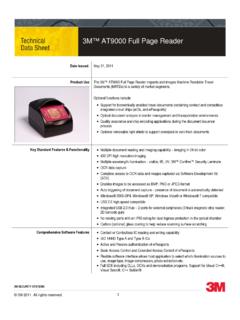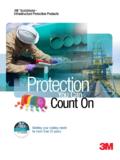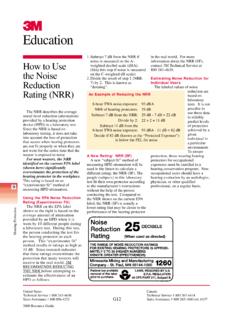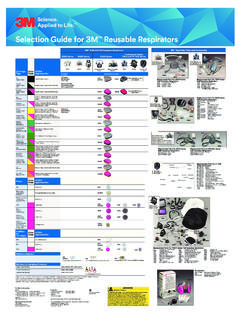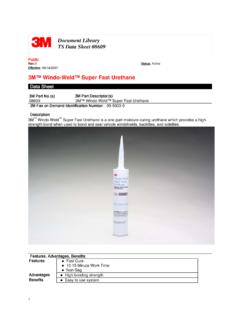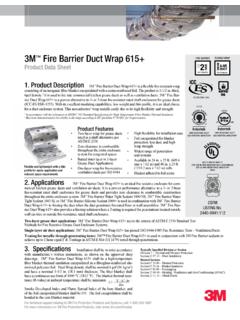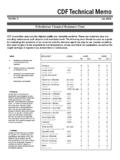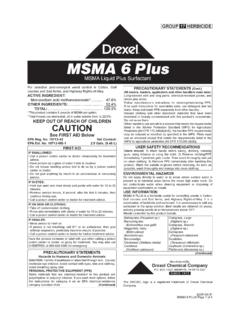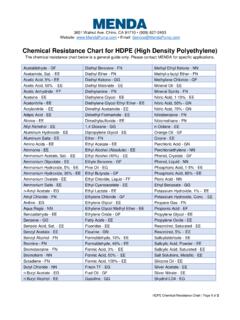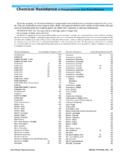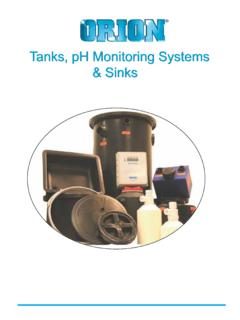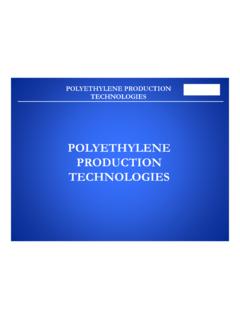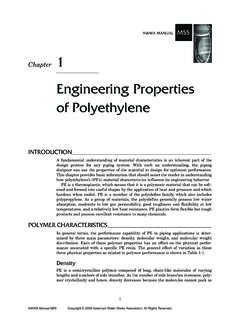Transcription of 3M Glass Bubbles K Series, S Series and iM Series
1 Product Information 3M Glass Bubbles K Series , S Series and iM Series Introduction Typical Properties 3M Glass Bubbles are engineered hollow Glass microspheres Not for specification purposes that are alternatives to conventional fillers and additives such as Isostatic Crush Strength silicas, calcium carbonate, talc, clay, etc., for many demanding Minimum applications. These low-density particles are used in a wide range Test Pressure Target Fractional Product Fractional (psi) Survival of industries to reduce part weight, lower costs and enhance Survival K1 250 90% 80%. product properties. K15 300 90% 80%. K Series K20 500 90% 80%. The unique spherical shape of 3M Glass Bubbles offers a number K25 750 90% 80%.
2 Of important benefits, including: higher filler loading, lower K37 3,000 90% 80%. K46 6,000 90% 80%. viscosity/improved flow and reduced shrinkage and warpage. It also helps the 3M Glass Bubbles blend readily into compounds S15 300 90% 80%. and makes them adaptable to a variety of production processes S22 400 90% 80%. S32 2,000 90% 80%. including spraying, casting and molding. S Series S35 3,000 90% 80%. S38 4,000 90% 80%. The chemically stable soda-lime-borosilicate Glass composition S38HS 5,500 90% 80%. of 3M Glass Bubbles provides excellent water resistance to create S60 10,000 90% 80%. more stable emulsions. They are also non-combustible and non- S60HS 18,000 90% 90%. iM Series porous, so they do not absorb resin.
3 And, their low alkalinity gives iM16K 16,000 90% 90%. 3M Glass Bubbles compatibility with most resins, stable viscosity iM30K 28,000 90% 90%. and long shelf life. 3M Glass Bubbles K Series , S Series and iM Series are specially True Density formulated for a high strength-to-weight ratio. This allows greater True Density (g/cc). survivability under many demanding processing conditions, such Product Typical Minimum Maximum as injection molding. They also produce stable voids, which results K1 in low thermal conductivity and a low dielectric constant. 3M Glass K15 K Series K20 Bubbles are available in a variety of sizes and grades to help you K25 meet your product and processing requirements.
4 K37 K46 S15 S22 S32 S Series S35 S38 S38HS S60 S60HS iM Series iM16K iM30K 3. 3M Glass Bubbles K, S and iM Series Typical Properties chemical resistance Packing Factor (Ratio of bulk density to true particle density). In general, the chemical properties of 3M Glass Bubbles Averages about 60%. resemble those of a soda-lime-borosilicate Glass . Oil Absorption Thermal Conductivity g oil/cc of 3M Glass Bubbles , per ASTM D281-84. Calculated Thermal Conductivity Product (W m-1 K-1) at 70 F (21 C) Volatile Content K1 Maximum of percent by weight. K15 K Series K20 K25 Alkalinity K37 Maximum of milliequivalents per gram K46 pH. S15 S22 Because 3M Glass Bubbles are a dry powder, pH is not defined.
5 The S32 pH effect will be determined by the alkalinity as indicated above. S Series S35 When 3M Glass Bubbles are mixed with deionized water at 5%. S38 S38HS volume loading, the resulting pH of the slurry is typically to S60 , as measured by a pH meter. S60HS Dielectric Constant iM Series iM16K K Series : to @ 100 MHz, based on theoretical calculations. iM30K S Series : to @ 100 MHz, based on theoretical calculations. Conductivity increases with temperature and product density. The iM Series : to @ 100 MHz, based on theoretical thermal conductivity of a composite will depend on the matrix calculations material and volume loading of 3M Glass Bubbles . The dielectric constant of a composite will depend on the matrix Thermal Stability material and volume loading of 3M Glass Bubbles .
6 Appreciable changes in bubble properties may occur above 1112 F. Particle Size (600 C) depending on temperature and duration of exposure. Flotation Particle Size (microns, by volume) 3M QCM Product Distribution Floaters (% by bulk volume) Effective 10th% 50th% 90th% Top Size Product Typical Minimum K1 96% 90% K1 30 65 115 120. K15 96% 90% K15 30 60 105 115. K Series 30 60 90 105. K Series K20 96% 90% K20. K25 96% 90% K25 25 55 90 105. K37 94% 90% K37 20 45 80 85. K46 92% 90% K46 15 40 70 80. S15 96% 90%. S15 25 55 90 95. S22 20 35 65 75. S22 96% 90% S32 20 40 70 80. S32 94% 90%. S Series S35 20 40 65 80. S Series S35 96% 90% S38 15 40 75 85. S38 94% 90% S38HS 19 44 70 85. S38HS 96% 90% S60 15 30 55 65.
7 S60 92% 90% S60HS 12 29 48 60. S60HS 92% 90%. iM Series iM16K 12 20 30 40. iM Series iM16K 96% 90%. iM30K 92% 90% iM30K Particle Size (continued) Minimum storage conditions should be unopened cartons in an Hard Particles (3M QCM ) unheated warehouse. No hard particles ( Glass slag, flow agent, etc.) greater than Under high humidity conditions with an ambient temperature number 40 (420 microns) standard sieve will exist. cycling over a wide range, moisture can be drawn into the bag Oversize Particles (3M QCM ) as the temperature drops and the air contracts. The result may For K1, K15, K20 and K25 Glass Bubbles : be moisture condensation within the bag. Extended exposure to Using a 10 gram sample on a number 80 standard sieve these conditions may result in caking of the 3M Glass Bubbles (177 microns), a maximum of five (5) percent by weight Glass to various degrees.
8 To minimize the potential for caking and Bubbles will be retained on the sieve. prolong the storage life, the following suggestions are made: For K37 and K46 Glass Bubbles : 1. Carefully re-tie open bags after use. Using a 10 gram sample on number 100 standard sieve 2. I f the polyethylene bag is punctured during shipping or (149 microns), a maximum of one (1) percent by weight Glass handling, use this bag as soon as possible, patch the hole, Bubbles will be retained on the sieve. or insert the contents into an undamaged bag. For S15, S32, S35, S38, S38HS, S60, S60HS, iM16K and iM30K 3. D. uring humid summer months, store in the driest, coolest Glass Bubbles : space available. Using a 10 gram sample on a number 140 standard sieve 4.
9 I f good storage conditions are unavailable, carry a (105 microns), a maximum of three (3) percent by weight Glass minimum inventory, and process on a first in/first Bubbles will be retained on the sieve. out basis. For S22 Glass Bubbles : Dusting problems that may occur while handling and processing Using a 10 gram sample on a number 200 standard sieve can be minimized by the following procedures: (74 microns), a maximum of five (5) percent by weight Glass 1. F. or eye protection wear chemical safety goggles. For Bubbles will be retained on the sieve. respiratory system protection wear an appropriate NIOSH/. MSHA approved respirator. (For additional information Appearance (3M QCM ).)
10 About personal protective equipment, refer to Material White to the unaided eye. Safety Data Sheet.). Flow (3M QCM ) 2. Use appropriate ventilation in the work area. 3M Glass Bubbles remain free flowing for at least one year from 3. P. neumatic conveyor systems have been used successfully the date of shipment if stored in the original, unopened container to transport 3M Glass Bubbles without dusting from in the minimum storage conditions of an unheated warehouse. shipping containers to batch mixing equipment. Static eliminators should be used to help prevent static charges. Labeling 3M Glass Bubbles will be packaged in suitable containers to help Diaphragm pumps have been used to successfully convey prevent damage during normal handling and shipping.
